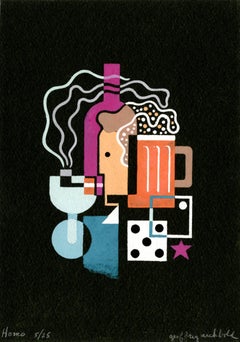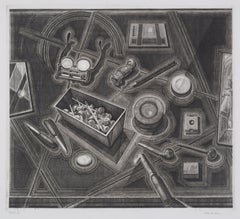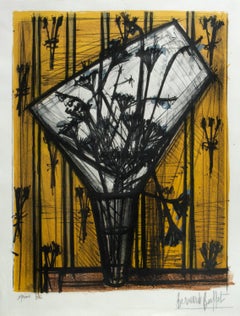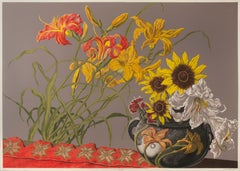Want more images or videos?
Request additional images or videos from the seller
1 of 7
Virginia DehnUntitled Floral Still Life1960's
1960's
$950List Price
About the Item
- Creator:Virginia Dehn (1922 - 2005, American)
- Creation Year:1960's
- Dimensions:Height: 14 in (35.56 cm)Width: 9.69 in (24.62 cm)
- Medium:
- Movement & Style:
- Period:
- Condition:
- Gallery Location:Fairlawn, OH
- Reference Number:Seller: AD077951stDibs: LU1409863962
About the Seller
5.0
Recognized Seller
These prestigious sellers are industry leaders and represent the highest echelon for item quality and design.
Platinum Seller
Premium sellers with a 4.7+ rating and 24-hour response times
Established in 1978
1stDibs seller since 2013
814 sales on 1stDibs
Associations
International Fine Print Dealers Association
Authenticity Guarantee
In the unlikely event there’s an issue with an item’s authenticity, contact us within 1 year for a full refund. DetailsMoney-Back Guarantee
If your item is not as described, is damaged in transit, or does not arrive, contact us within 7 days for a full refund. Details24-Hour Cancellation
You have a 24-hour grace period in which to reconsider your purchase, with no questions asked.Vetted Professional Sellers
Our world-class sellers must adhere to strict standards for service and quality, maintaining the integrity of our listings.Price-Match Guarantee
If you find that a seller listed the same item for a lower price elsewhere, we’ll match it.Trusted Global Delivery
Our best-in-class carrier network provides specialized shipping options worldwide, including custom delivery.You May Also Like
Classic Botanical Cyanotype, Handmade Using Natural Sunlight, Limited Edition
By Kind of Cyan
Located in Barcelona, ES
This is an exclusive handprinted limited edition cyanotype.
Details:
+ Title: Vintage Pressed Flowers Nº3
+ Year: 2023
+ Edition Size: 20
+ Stamped and Certificate of Authenticity provided
+ Measurements : 70x100 cm (28x 40 in.), a standard frame size
+ All cyanotype prints are made on high-quality Italian watercolor paper
WHAT IS A CYANOTYPE?
The cyanotype (a.k.a. sun-print) process is one of the oldest in the history of photography, dating back to the 1840's.
Cyanotypes were then made famous by Anna Atkins, considered the first female photographer. Inspired by nature, we feel the need to look back at a craft that is handmade, analogue, and using an all-natural light source: the sun.
Our cyanotypes are made by coating high-quality Italian watercolor paper with a light-sensitive emulsion. We then expose it in direct sunlight for several minutes using a photo negative...
Category
2010s American Modern Still-life Prints
Materials
Emulsion, Watercolor, Paper, Lithograph
$420
H 39.38 in W 27.56 in
After Pablo Picasso - The Basket
Located in Collonge Bellerive, Geneve, CH
With the printed signature of Picassp and date, as issued
Based on an original composition of 1920, printed in 1946
Picture Dimensions: 21 x 31 cm.
Sheet Dimensions: 31 x 41 cm
Prin...
Category
1920s American Modern Abstract Prints
Materials
Lithograph
Save your Child, Buy War Savings Stamps World War 1 vintage poster
By Herbert Paus
Located in Spokane, WA
Original World War 1 vintage poster: Save Your Child from Autocracy and Poverty. Buy War Savings Stamps. W.S S. (Small Format). This poster for War Savings Stamps features a small blond child wearing nothing but shoes and socks. He is clutching the arm of the Statue of Liberty. The poster was designed by Minneapolis born Herbert Paus. His most noted work is found in the famed advertising campaigns for Victor Records...
Category
1910s American Modern Still-life Prints
Materials
Lithograph
$540 Sale Price
20% Off
H 30 in W 20 in D 0.1 in
Grapes
By Marsden Hartley
Located in New York, NY
A superb, richly-inked impression of this early, very scarce lithograph. Signed and dated in pencil, lower right.
Category
1920s American Modern Still-life Prints
Materials
Lithograph
Original "SAVE A LOAF A WEEK, Help Win the War" vintage World War One poster
Located in Spokane, WA
Original rare poster: SAVE A LOAF A WEEK - HELP WIN THE WAR. Original WW1, 1917, U. S. Food Administration antique American poster. Artist sig...
Category
1910s American Modern Still-life Prints
Materials
Lithograph
$690
H 29 in W 22 in D 0.05 in
Original Cultivez des Oleagineux French mid-century vintage poster
Located in Spokane, WA
Original 'La France Manque d’Huile, cultivez des Oleagineux' vintage French poster. Linen backed in excellent condition, ready to frame. FREE Continential USA shipping.
Transpor...
Category
1940s American Modern Still-life Prints
Materials
Lithograph
$476 Sale Price
20% Off
H 15.38 in W 22.5 in D 0.05 in
Dau Fuskie (The First Race Between the Turtle and the Hare)
By John Biggers
Located in New York, NY
Lithograph, 1998. Signed by the artist and dated in pencil, lower right. Numbered 99/200 in pencil, lower left.
Full margins. Overall sheet dimension is 15.25 x20 inches.
Category
1990s American Modern Animal Prints
Materials
Lithograph
$2,000
H 10 in W 13.75 in
Pamela Bianco, Fruit Piece
Located in New York, NY
Pamela Bianco achieve success as an artist in Britain while still a child. This accomplishment resulted in the family coming to the United States where ...
Category
1920s American Modern Still-life Prints
Materials
Lithograph
Blue Hydrangea, oversize lithograph, classical architectural elements
Located in Brooklyn, NY
Blue Hydrangea - image bled to plate size ~ 39 x 29 - printed on 100% cotton rag - edition 3/5
Architectural elements
Category
Early 2000s American Modern Interior Prints
Materials
Archival Ink, Archival Paper, Rag Paper, Lithograph
$800 Sale Price
20% Off
H 39 in W 29 in
1960s Original Lithograph Del Monte Tomato Sauce Can I
Located in Arp, TX
Artist unknown
"Tomato Sauce I"
c. 1960s
Lithograph on paper
18.5"x23" unframed
unsigned
Category
1960s American Modern Still-life Prints
Materials
Paper, Lithograph
More From This Seller
View All"Homo" Verne
By Geoffrey Archbold
Located in Fairlawn, OH
"Homo"Verne, (Still Life with wine bottle, wine glass, glass of beer and dice)
Pochoir printed on black textured colored paper, c. 1930
Signed and numbered in white pencil by the art...
Category
1920s American Modern Still-life Prints
Materials
Screen
Engraver's Tools
By Armin Landeck
Located in Fairlawn, OH
Engraver's Tools
Engraving, 1974
Signed and annotated in pencil by the artist (see photos)
This a "Trial Proof" impression with graphite additions
Regular Edition: 100
References And...
Category
1970s American Modern Still-life Prints
Materials
Engraving
Flowers
By Bernard Buffet
Located in Fairlawn, OH
Flowers
Color lithograph
Signed in pencil (see photo)
Annotated in pencil "Eprueve HC" (see photo)
A trial proof reserved for the artist
Printed by Mourlot, Paris
First edition was 1...
Category
1950s Post-Modern Still-life Prints
Materials
Lithograph
Buds
By Jack Beal
Located in Fairlawn, OH
Buds
Color lithograph, 1980
Signed, titled, and editioned in pencil by the artist
Publisher: Art Matters
Printer: Bud Shark, Shark's Ink, Lyons, CO
Condition: Excellent
Image: 31-1/8 x 41-1/4" (79 x 104.7 cm.)
"An Abstract Expressionist when he left the Art Institute of Chicago in 1956, Beal has since become a dedicated realist who sees art as a potentially powerful moral force. He has great regard for Platonic ideals of truth, beauty, and goodness, and admires both the realism of seventeenth-century Dutch painting and the compositional authority of Renaissance art. Since moving to New York in the late 1950s with his wife, painter Sondra Freckelton, Beal has painted still lifes, portraits, and landscapes, although in recent years his most ambitious undertakings have been large-scale allegories and myths. In describing his approach, Beal calls himself a "life painter" and says he is committed to human over aesthetic concerns. Yet his intricate complexes of figures and surface patterns, along with his adroit handling of space, reveal his sophisticated, accomplished sense of composition.
Virginia M. Mecklenburg
Biography
Jack Beal (1931-2013) was born and raised in Richmond, Virginia. He briefly attended the College of William and Mary, studying biology, but dropped out after two years. A decision to take evening art classes lead to his attending the Art Institute of Chicago, where he studied from the old masters in the Institute’s collection and with Isobel Steele MacKinnon, a student of Hans Hoffman. His classmates there included Red Grooms, Richard Estes, Claes Oldenberg and Robert Barnes, and while abstract expressionism remained “the only valid way to paint,” it was a style that all would eventually reject. In 1956 Beal left the Art Institute and moved to New York with the aim of finding success as a painter, eventually becoming one of the first artists to settle in the SoHo neighborhood.
A turning point came in 1962 when, spending the summer in upstate New York, Beal decided to begin painting outdoors. Dissatisfied with abstract painting, he “wanted to give Art one more try” and in working from nature “fell in love with painting all over again.” Over the next few years Beal worked toward a balance between expressionistic paint handling and realistic, narrative pictures. Clement Greenberg’s pronouncement around this time, that the figure was no longer a valid subject was taken as a challenge by many artists, Beal included. His subsequent adoption of the female nude - modeled by his wife, the artist Sondra Freckelton - was a break-through. Though the paintings retained the sensuousness of his earlier canvases, the rigorous formality of their composition and the masterful treatment of light and shadow offered a new approach to realist painting. Indeed, Beal was not alone in this transformation; friends and colleagues in New York were coming to similar conclusions and the group, who included painters such as Philip Pearlstein, Alfred Leslie, Yvonne Jacquette, Alex Katz, Jack Tworkov, Nell Blaine and Fairfield Porter, would eventually be considered the ‘New Realists.’
With the resurgence of figurative painting, Beal distinguished himself for his skillful handling of color and modeling as well as what was later described as his “pushing of representational forms to their interface with abstraction”. Through the later half of the 1960s, while his subject matter remained unchanged, his paintings were increasingly given over to wide areas of flat color. In 1969, he exhibited a series of Table Paintings which, with their hard-edge style and near complete abstraction of the form, were a radical departure for Beal. So radical in fact, he was accosted by fellow realist painters Alfred Leslie and Sidney Tillim, who berated him “for betraying realism and betraying [himself], for moving away from ‘the true path’.” The incident had its intended effect and Beal did return to a more naturalistic and humanistic style, eventually abandoning the nude in favor of increasingly allegorical portraits. In 1974, the United States General Services Administration commissioned Beal to produce a series of murals for the U.S. Department of Labor headquarters in Washington D.C. The result was The History of Labor, four, 12 x 13 foot paintings in the vein of George Caleb Bingham, each illustrating a century of American development.
Following the completion of the murals in 1977, Beal continued to make use of narrative in his paintings, with portraiture and self-portraiture as a means of exploring moral and didactic themes. He and Sondra had purchased an old mill in upstate New York in 1974 and after extensive renovations, it became their permanent residence. Unsurprisingly, many of his later paintings are pastoral scenes based on his rural surroundings or still lives including flowers which they grew on the property. In 1986, Beal was commissioned by the Art in Transit Initiative to create a large-scale mural as part of the redevelopment of the Times Square Subway Station. The proposed mosaic mural, The Return of Spring, took over fifteen years to complete, with the two, 7 x 20 foot sections finally installed in 2001 and 2005. Together they update the Greek myth of Persephone with a New York setting, showing her abduction by Hades, initiating the arrival of winter, and her release, bringing the bountiful return of spring.
Beal was a founder of the Artist’s Choice Museum, New York and the New York Academy of Art as well as the recipient of numerous grants and awards, including honorary degrees from the Art Institute of Boston and the Hollins College...
Category
1980s Contemporary Still-life Prints
Materials
Lithograph
$1,200
La Terrazza
By Jeanette Pasin-Sloan
Located in Fairlawn, OH
La Terrazza
Lithograph, 1987
Signed, titled and numbered in pencil (see photos)
Published by Kandfall Press, Chicago (their stamp verso)
Landfall drystamp recto lower left
Edition 12...
Category
1980s Photorealist Still-life Prints
Materials
Lithograph
La Tasse et la Pomme (The Cup and the Apple)
By Pablo Picasso
Located in Fairlawn, OH
La Tasse et la Pomme (The Cup and the Apple)
Wash drawing and gouache transferred to lithograph stone, 1947
One of four unsigned proofs
Edition: a proof outside the edition of 50 pri...
Category
1940s French School Still-life Prints
Materials
Lithograph



